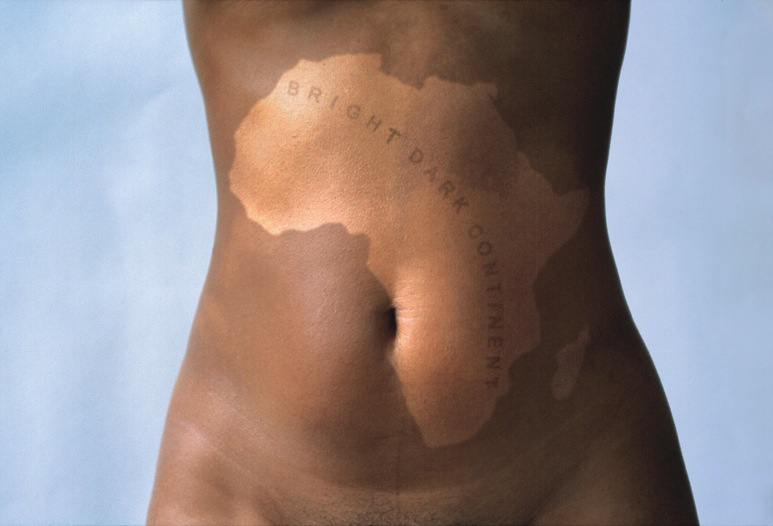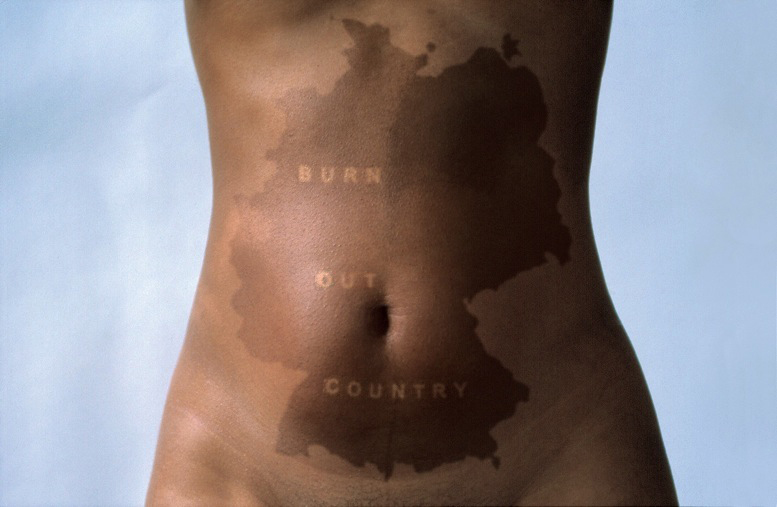Body As Art
Ingrid Mwangi Speaks from the Body
Many contemporary women artists use their body to make a political statement. Artist Ingrid Mwangi is one of them, creating work that is innovative, visually striking and often shocking. She spent the first 15 years of her life in Kenya and has been living in Germany ever since. Through photography, performance, sound, installation and video, she's created a "body of work" that questions both social and political conventions. Mwangi writes: My body is the only thing that I own... I react, interpret and question the clichés and stereotypes with which I am faced... I use art to awaken consciences.
Body Photographs
Mwangi's 2001 photo series, "Static Drift" is, literally, body art. Her stomach is her medium. In each photo, Mwangi covered her skin with a stencil, and sat in the sun to let the exposed parts tan.
In the first photo, a pale map of Africa appears onto her tan stomach, with the English words "Bright Dark Continent." In the second photo, it is the map that is dark, and the surrounding skin, pale. Within the outline of Germany we read the English words: "Burn Out Country."
Through this series, Mwangi communicates the complexities of being a bi-racial woman in exile. When living in Africa, she says, she is seen as white; but in Germany, she is black.
In her book Your Own Soul, Mwangi's work is summarized this way:
"Ingrid Mwangi experiments with her own body, likening it to an open book upon which her own national and racial lineage is both written and read. ... National titles and geographic borders are displaced from their habitual contexts, causing one to contemplate what nationalism, skin color, and ethnic identity mean when physically inscribed on a body-particularly a female body. Within the dichotomy of Mwangi's personal biography the historical relationship between Germany and Africa, colonizer and colonized, oppressor and the oppressed, is also powerfully evoked."
Body Performance and Video
Many of Mwangi's video and performance pieces include hair: cutting hair, using hair as a mask, dreadlocked hair. In performance, Mwangi's voice is powerful and unsettling. She chirps, shouts and screeches in primal tones.
About Mwangi's performance work, critic Laurie Ann Farrell writes:
"Working with video as an open medium of image and sound, Mwangi began to work with and alter images of her body as a means of collapsing oversimplified narratives of race, gender and sexuality....Mwangi's videos blend beautiful images with the edge of brutality embedded in racial stereotypes."
Mwangi, herself, writes:
"Working in this way with new media, my main focus is to develop a body of artwork that revolves around conditions of human existence and the difficult questions of how to deal with the violence, injustice and suffering in our world. My work does not directly influence people's lives, help their economic situation or give them specific skills with which to improve their lives. Still, I feel that I am contributing to the development of society in the area of awareness."
Merging Body Identities
Recently, Mwangi has carried her explorations of identity to the next step. She has merged her artistic identity with that of her husband, Robert Hutter. They now share the same name. She says:
"I'm IngridMwangiRobertHutter. And I try to develop a consciousness in which I have those two bodies. So when I make art, I put that masculine white body in relationship to this feminine "black" body. This is very exciting, because we are dealing with the materiality of the body. It expands the breadth of the whole theme: the concept for me comes from living. It's how you live it, how you work with it, how it manifests itself, rather than just projecting the idea that we want to be one person."
To learn more about Ingrid Mwangi visit www.ingridmwangiroberthutter.com



